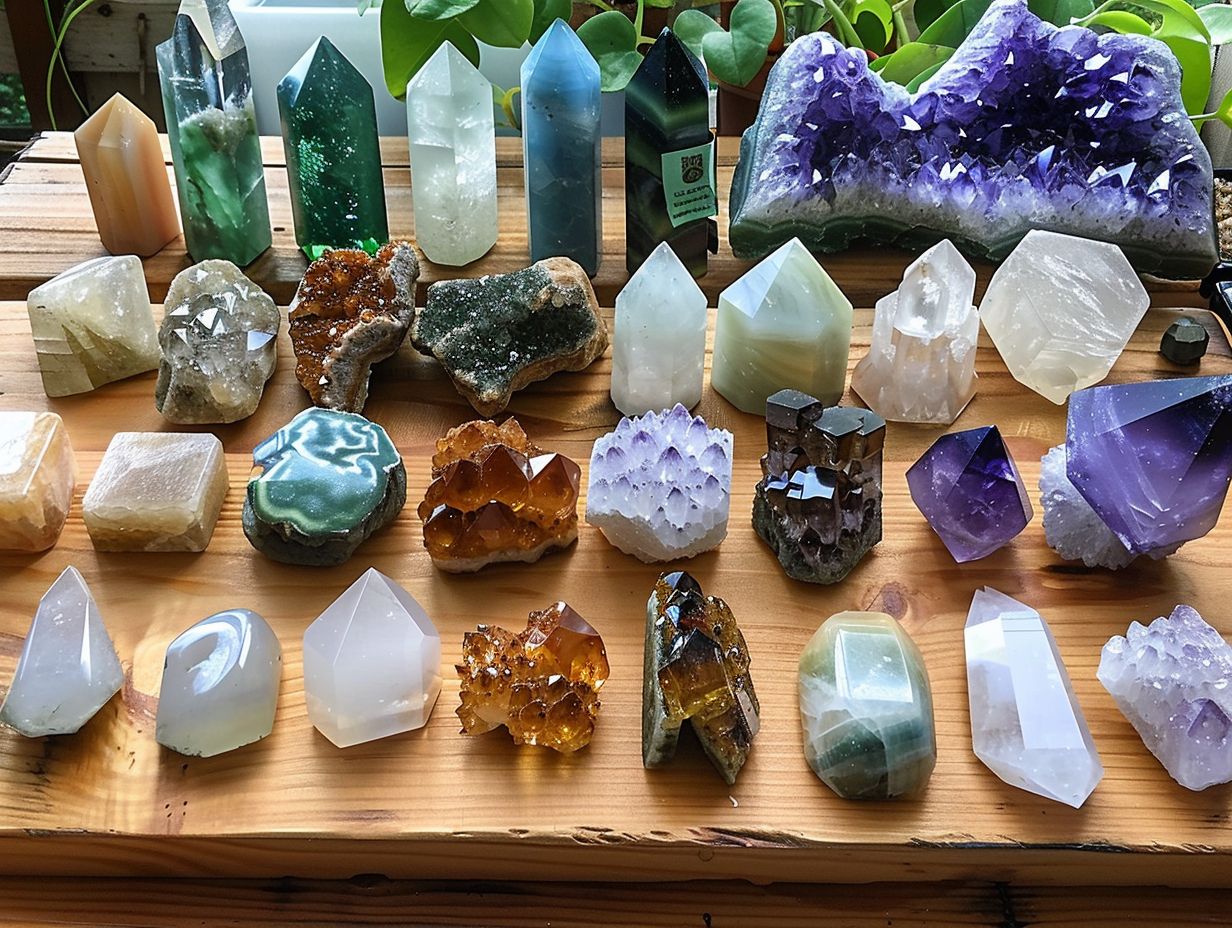
The Ultimate Guide to Crystals for Managing Work Stress
Feeling overwhelmed by work stress is a common experience shared by many individuals. This comprehensive guide will examine the causes and impacts of work stress on mental health, while also exploring the potential benefits of utilizing crystals as a method for effective stress management.
The guide will provide an in-depth analysis of the top crystals recommended for combating work stress, detailing their unique properties and optimal applications. Additionally, practical advice on seamlessly integrating crystals into one’s daily routine will be offered, alongside insights into supplementary stress management techniques such as meditation and breathing exercises. By combining the use of crystals with other stress relief methods, individuals can potentially enhance their outcomes and promote a greater sense of well-being.
Ultimately, this resource aims to serve as a comprehensive tool for individuals seeking to cultivate balance and tranquility within the demanding landscape of a busy work environment.
Understanding Work Stress
Comprehension of work-related stress is essential for enhancing mental health and emotional well-being, as stress originating from work affects numerous individuals, resulting in heightened anxiety, decreased productivity, and various health complications.
Causes and Impact on Mental Health
Work-related stress can arise from a variety of factors, including heavy workloads, tight deadlines, and inadequate support, all of which can have a significant impact on mental health and result in heightened levels of anxiety.
These stressors present in the professional environment can induce feelings of being overwhelmed and under pressure, triggering anxiety and impeding one’s ability to manage challenges effectively. The persistent sensation of being overextended and the apprehension of failing to meet expectations can further intensify the cycle of stress and anxiety.
Consequently, this can lead to a decrease in focus and concentration, ultimately affecting overall productivity. The negative impact of work-related stress on emotional well-being can extend beyond the workplace, perpetuating a harmful cycle of adverse effects on mental health in personal life.
What are Crystals and How They Work
Crystals are natural minerals that are commonly believed to possess inherent healing properties purported to influence the flow of energy and chakras, thereby promoting spiritual and physical well-being.
These aesthetically pleasing gemstones are understood to interact with the body’s energy field, facilitating the balancing and harmonization of the energy flow within the individual. Each crystal is thought to emit a distinct vibration and energy that can resonate with specific chakras in the body, serving to clear any blockages and restore equilibrium.
Through the application of crystal healing, individuals are said to experience feelings of tranquility, mental clarity, and emotional healing. It is not uncommon for many individuals to integrate crystals into their daily routines as aids for self-care, meditation, and the promotion of overall well-being.
Top Crystals for Managing Work Stress
Numerous crystals are celebrated for their capacity to mitigate work-related stress and foster stress relief, each presenting distinct advantages and attributes that augment emotional wellness.
Properties and Uses of Each Crystal
Various types of crystals offer unique properties that can be harnessed for stress relief and emotional well-being. For example, Amethyst is recognized for its calming and balancing effects. Rose quartz, another commonly utilized crystal, is connected with love and compassion, with its gentle energy aiding in promoting self-love and healing emotional wounds. Citrine, a vibrant and radiant crystal, is frequently employed to enhance joy and positivity while dispelling negative energies. Black tourmaline is renowned for its protective attributes, shielding individuals from adverse influences. Additionally, Lapis lazuli is thought to improve communication and reveal inner truth.
When these crystals are used with purpose, they can assist in reducing stress, fostering emotional equilibrium, and enhancing overall well-being.
How to Use Crystals for Managing Work Stress
Incorporating crystals into stress management methodologies can prove to be a highly efficacious approach in mitigating work-related stress, fostering relaxation, and enhancing productivity.
Incorporating Crystals into Daily Routine
The integration of crystals into one’s daily regimen has been shown to promote relaxation, enhance productivity, and facilitate stress reduction, presenting a practical method for managing work-related stress.
An effective approach to integrating crystals into daily routines involves the establishment of a crystal grid within the workspace. This technique entails the strategic arrangement of crystals in a designated pattern to amplify their energy and intent. By selecting crystals that align with characteristics such as focus, clarity, and serenity, individuals can augment their productivity levels and cultivate a harmonious work environment.
Furthermore, the utilization of crystal jewelry, such as a quartz bracelet or amethyst necklace, can offer a continuous subtle energy flow throughout the day. This sustained support contributes to overall well-being and assists individuals in maintaining equilibrium amidst the various demands encountered in the professional sphere.
Additional Techniques for Stress Management
Incorporating supplementary stress management methods like meditation, mindfulness, and breathing exercises, alongside the utilization of crystals, can substantially augment one’s self-care regimen and facilitate the cultivation of a comprehensive approach to wellness.
Meditation, Breathing Exercises, and More
Meditation and breathing exercises serve as potent tools for achieving relaxation, inner peace, and tranquility, rendering them valuable additions to an individual’s stress management regimen.
To engage in meditation, it is advisable to secure a quiet and comfortable environment where disturbances are minimal. Situating oneself in a relaxed posture, whether seated or lying down, with closed eyes, is recommended. Direct your focus towards your breath, taking deliberate and unhurried inhalations through the nostrils and exhalations through the mouth.
Allow thoughts to enter and exit without passing judgment. Through consistent engagement with this practice, one can observe a development of calmness and mental lucidity. Furthermore, breathing techniques such as diaphragmatic breathing or box breathing are effective in regulating heart rate and diminishing stress levels.
Combining Crystals with Other Stress Management Methods
The integration of crystals with additional stress management techniques has the potential to magnify their efficacy, fostering a synergistic relationship that bolsters relaxation, cultivates positive energy, and contributes to holistic well-being.
Enhancing Results with Complementary Techniques
Augmenting the efficacy of stress management practices can be achieved by integrating complementary techniques such as Reiki energy healing and aura cleansing. These additional methods can substantially heighten the positive effects and benefits derived from stress management efforts.
Reiki energy healing is a modality that directs universal life force energy to instill relaxation and equilibrium within the body. When combined with crystal healing, Reiki energy can synergistically enhance the healing properties of crystals. By incorporating Reiki sessions alongside crystal healing practices, individuals can optimize the energetic balance within their holistic being.
Similarly, aura cleansing methods like smudging with sage or utilizing sound healing tools can aid in removing energetic blockages. This purification process facilitates the optimal functioning of crystals in re-establishing harmony and equilibrium within the individual. By adopting this comprehensive approach, not only are physical symptoms addressed, but emotional and spiritual well-being are also revitalized. This integration promotes a profound sense of tranquility and optimism within the individual.




No Comments